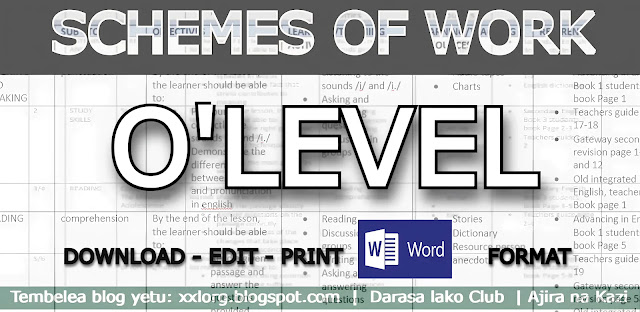Secondary school form 1 to form 4 Schemes of Work| 2025
A scheme of work is a detailed plan that outlines the content, activities, and teaching strategies for a course or subject over a specific period. It serves as a guide for teachers, helping them organize and structure lessons while ensuring that all learning objectives and outcomes are met. A well-designed scheme of work provides a roadmap for teaching and learning, and it is particularly useful in ensuring continuity, clarity, and progress in the subject matter.
FORM ONE SCHEMES OF WORK ALL SUBJECTSComponents of a Scheme of Work
Title/Subject: The subject or course for which the scheme of work is created (e.g., Mathematics, History, English).
Learning Objectives: Clear, measurable objectives that students are expected to achieve by the end of the course or lesson. These should be specific, achievable, and aligned with the overall curriculum.
Content/Topics: The specific subject matter or concepts that will be covered during the course. This is often broken down into individual lessons or units.
Teaching Methods/Activities: The methods or strategies to be used for teaching, including lectures, group work, hands-on activities, discussions, and any other relevant teaching approaches.
Resources: The materials, tools, and resources needed for teaching and learning, such as textbooks, software, multimedia, and physical resources.
Assessment: Methods to assess student learning, including quizzes, exams, group presentations, assignments, or practical assessments. This also outlines how the students' progress will be evaluated.
Timeframe: The duration of each topic or lesson, including how long it will take to complete each activity and how many lessons will be devoted to a specific subject or unit.
Differentiation: Approaches for meeting the needs of diverse learners. This may include adapting the lessons for different learning styles, abilities, or language levels.
Homework/Assignments: Any homework tasks or assignments to be given, with their due dates and purpose.
Evaluation/Reflection: A space to reflect on how effective the scheme was after it’s completed. This may include teacher feedback on the lessons, areas for improvement, or adjustments for future schemes.
Example Scheme of Work Format
Subject: English Literature
Grade: 10
Duration: 6 Weeks
Topic: Shakespeare’s Romeo and Juliet
| Week | Topic | Learning Objectives | Teaching Activities | Resources | Assessment |
|---|---|---|---|---|---|
| Week 1 | Introduction to Romeo and Juliet | - Understand the context of Shakespeare’s work. - Introduce the main themes in the play. | - Lecture on Shakespeare’s life and era. - Group discussion on themes of love, family, and conflict. | Textbook, Projector, Clips from play | Quiz on historical context and themes. |
| Week 2 | Act 1: Scene 1-5 | - Identify characters in the opening scenes. - Analyze the relationship between Romeo and Juliet. | - Read Act 1 together. - Discuss character motivations. | Play script, Whiteboard | Short written response on Act 1 themes. |
| Week 3 | Act 1: Scene 6-7 and Act 2: Scene 1-2 | - Discuss the development of Romeo and Juliet’s relationship. | - Role-play key scenes. - Debate the role of fate in their relationship. | Play script, Clips from the play | Group presentation on Act 1-2. |
| Week 4 | Act 2: Scene 3-6 and Act 3: Scene 1-2 | - Explore the consequences of decisions in the play. | - Read scenes aloud. - Group work on character decisions and consequences. | Play script, Whiteboard | Homework on analyzing character decisions. |
| Week 5 | Act 3: Scene 3-5 | - Discuss the turning point of the play. - Explore the role of family conflict. | - Guided reading and analysis of key scenes. - Watch an adaptation of the scene. | Projector, Textbook | Essay on the role of family conflict. |
| Week 6 | Act 4-5: Conclusion and Review | - Analyze the tragedy’s conclusion. - Reflect on the themes of fate and free will. | - Review and discussion of the ending. - Final exam preparation. | Play script, Review sheet | Final test on the play’s themes and characters. |
Types of Schemes of Work
Unit Scheme of Work: Focuses on a particular unit or module of the curriculum, often used for a subject like Mathematics or Science, where each unit is a standalone chunk of content.
Lesson Scheme of Work: Focuses on a specific lesson or set of lessons, breaking down individual topics in smaller, manageable chunks.
Termly or Yearly Scheme of Work: A longer, more detailed plan that covers all topics for a term, semester, or year, offering a broad overview of the learning objectives and key dates.
Thematic Scheme of Work: Organizes the content around a central theme, where different topics are linked by the theme (e.g., "The Natural World" in Science or "Power and Authority" in History).
Benefits of a Scheme of Work
- Organization: Helps teachers stay on track with curriculum goals and ensures lessons are properly sequenced.
- Consistency: Provides a structured approach to teaching, ensuring that students are taught all required topics.
- Time Management: Aids in pacing lessons and making the most of instructional time.
- Assessment Alignment: Ensures assessments are planned in alignment with learning objectives and outcomes.
- Adaptability: Makes it easier for teachers to adjust plans based on students' needs or other external factors.
Conclusion
Creating a scheme of work is a valuable tool for both new and experienced teachers, helping them plan effectively, meet curriculum goals, and provide engaging and organized lessons.


